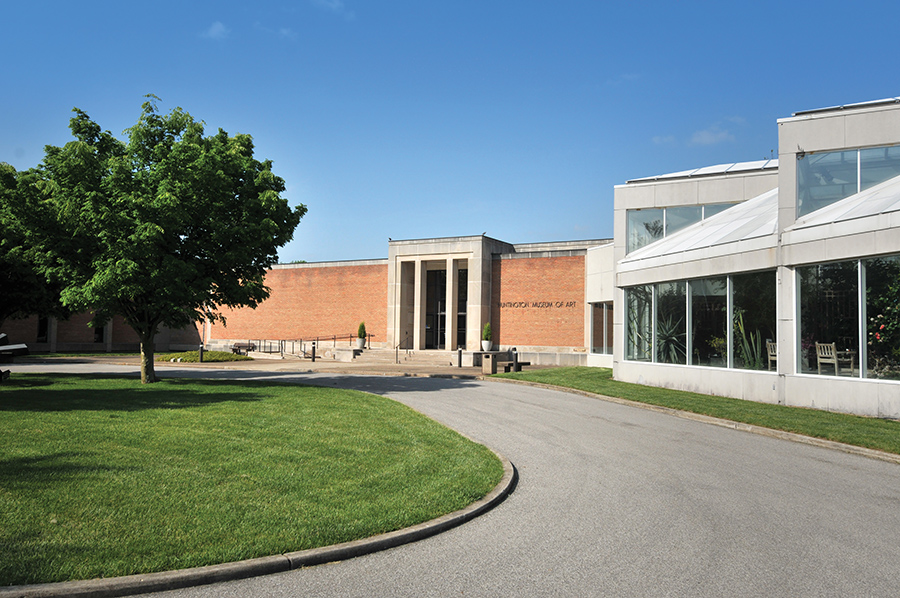By James E. Casto
HQ 100 | WINTER 2018
For more than six decades, the Huntington Museum of Art (HMA) has been defined by vision — a vision of bringing the world of art to the people of West Virginia and the Tri-State. That vision, nurtured by the generosity of the museum’s founders and its many supporters, has led to the creation of a truly distinguished fine art museum, the largest between Pittsburgh and Cincinnati.
Originally known as the Huntington Galleries, the museum opened in 1952. The beginnings of the HMA art collection resulted from an extraordinary gift by Herbert Fitzpatrick, a prominent Huntington attorney who donated his own collection of 435 artworks and the 52-acre site on which the museum was built.
Fitzpatrick’s collection of paintings, prints, English silver and Islamic prayer rugs was soon augmented by other gifts of individual art collections, disparate in nature, but uniform in their high standards of quality. HMA has continued to build upon the collecting blueprint that was established in its beginning stages, adding objects of comparable quality that enhance its ability to serve its audience.
Today, the museum boasts an exceptional collection, innovative exhibitions and educational programs, a landmark facility and a beautiful site where art and nature blend in harmony.
Huntington Quarterly asked HMA Senior Curator Christopher Hatten to select 10 of the most significant pieces of art in the museum’s collection. His selections are presented on the following pages.
“They’re not necessarily the most valuable pieces in the museum’s collection,” Hatten said, but a selection that offers a comprehensive overview of the world of art.
In addition to the 10 artworks HQ requested, Hatten added an 11th selection certain to resonate with Marshall University fans.
Alexander Calder (American, 1898-1976) Red G, 1963
Step through the front door of the Huntington Museum of Art, crane your neck to look up and you will see a painted steel and wire construction called a “mobile” by its creator, Alexander Calder, whose distinctive work helped redefine the world of sculpture. “I want to make things that are fun to look at,” Calder said. And he certainly succeeded.
Dale Chihuly (American, born 1941) The Huntington Museum of Art Tower, 2006
Dale Chihuly is surely the most recognizable name in contemporary studio glass. This massive glass sculpture — six feet wide and 10 feet tall — graces the center of the museum’s C. Fred Edwards Conservatory. The colorful sculpture is best-viewed and most dramatic at night, thanks to the special lighting illuminating it. The children of longtime museum supporters Lake and Dorothy Polan purchased this piece that graces the conservatory in memory of their parents.

Childe Hassam (American, 1859-1935) Lincoln’s Birthday Flags, 1918
Childe Hassam was fascinated by the patriotic displays to be seen along New York City’s Fifth Avenue during World War I. Determined to offer his own personal support for the war effort, Hassam produced a colorful series of paintings depicting the avenue’s flag-draped buildings.

Winslow Homer (American, 1836-1910) The Garden Wall, 1880
Largely self taught, Winslow Homer mastered a variety of artistic media, ranging from the woodcuts and engravings he did for books and magazines early in his career to the expressive sea paintings he did in later life. In the 1870s, he began to seriously paint in watercolors. “The Garden Wall” is a splendid example of his watercolor skills.

Harvey Littleton (American, 1922-2013) Opportunity Trap, 1970
Harvey Littleton grew up in Corning, New York, and as a young man had an opportunity to work with glass at Corning Glass Works. After serving in World War II, he became a successful ceramics artist, when a trip to the famed glass studios at Murano, Italy, revived his interest in glass. “Opportunity Trap” exemplifies his role in moving art glass from the factory floor to the studios of individual artists.

Robert Motherwell (American, 1915-1991) Alberti Suite No. 9, 1970
One of the best-known painters of the 20th century, Robert Motherwell began his “Open” series of works in 1968. Like “Alberti Suite No. 9,” the paintings and prints in the series generally feature a field of solid color within which a group of narrow lines form one or more incomplete rectangles. The painting’s title reflects Motherwell’s admiration for Spanish painter and poet Rafael Alberti.

Hiram Powers (American, 1805-1873) Proserpine, circa 1844
Hiram Powers was one of the most important American sculptors of the 19th century. Spurred on by a standing offer from a Philadelphia collector who wanted an original work, he completed this beautiful example of neoclassical sculpture around 1844. The piece proved so popular that Powers, as astute in business as he was in art, was able to sell more than 150 replicas of it.

John Singer Sargent (American, 1856-1925) Near June Street, Worcester, Massachusetts, 1890
Born to American parents in Florence, Italy, John Singer Sargent frequently traveled in Europe and the United States, often sketching and painting the local scenery. In 1890, he visited Worcester, Massachusetts, where he painted a number of works, including two views of June Street. One view is a watercolor now owned by the Mead Art Museum at Amherst College. The other is this oil in the HMA collection.

Carrie Mae Weems (American, born 1953) Untitled (Putting on Make-Up), 1990-1999
Carrie Mae Weems is an African American artist who works with text, fabric, audio, digital images and installation video, but is best known for her photography. “Putting on Make-Up” is part of her widely acclaimed “Kitchen Table Series.” Weems was a guest artist at HMA in 2006 as part of the Walter Gropius Master Artist Series.

Paul Storr (English, 1771-1844) Waterford Glassworks Cruet Stand, 1801-1802
HMA’s extensive collection of English silver includes this exquisite cruet stand, purchased by Herbert Fitzpatrick from Edward, Duke of Windsor. Edward is best known as the British monarch who abdicated his throne in 1937 to marry American socialite Wallis Simpson. Fitzpatrick described the cruet stand as “the most beautiful thing of its sort which I have ever seen.”

Harry Bertoia (American, 1915-1978) Maquette for Marshall University Memorial Fountain
Artist Harry Bertoia ventured into sculpture in the 1940s, translating many of his drawings and prints into welded metal sculptures. He was chosen to design the Marshall University Memorial Fountain that stands outside the university’s Memorial Student Center. Installed in 1972, the large-scale work is a memorial to the 75 Marshall football players, school officials and community members who died in 1970 when their plane crashed at Tri-State Airport. The maquette for the work (a small preliminary model) is in the HMA collection.






